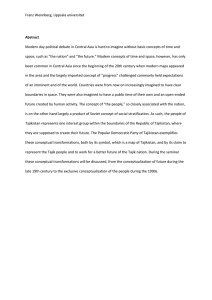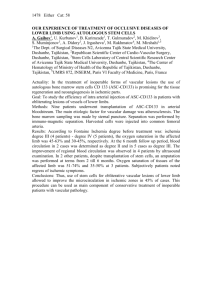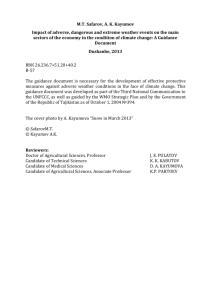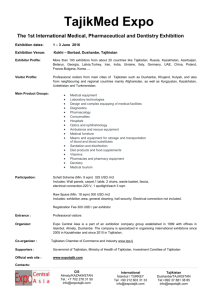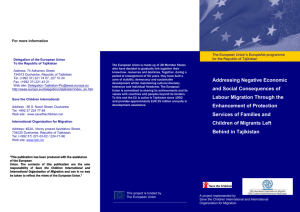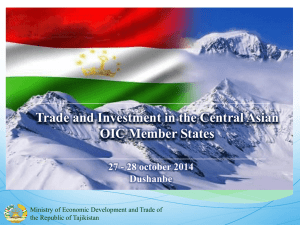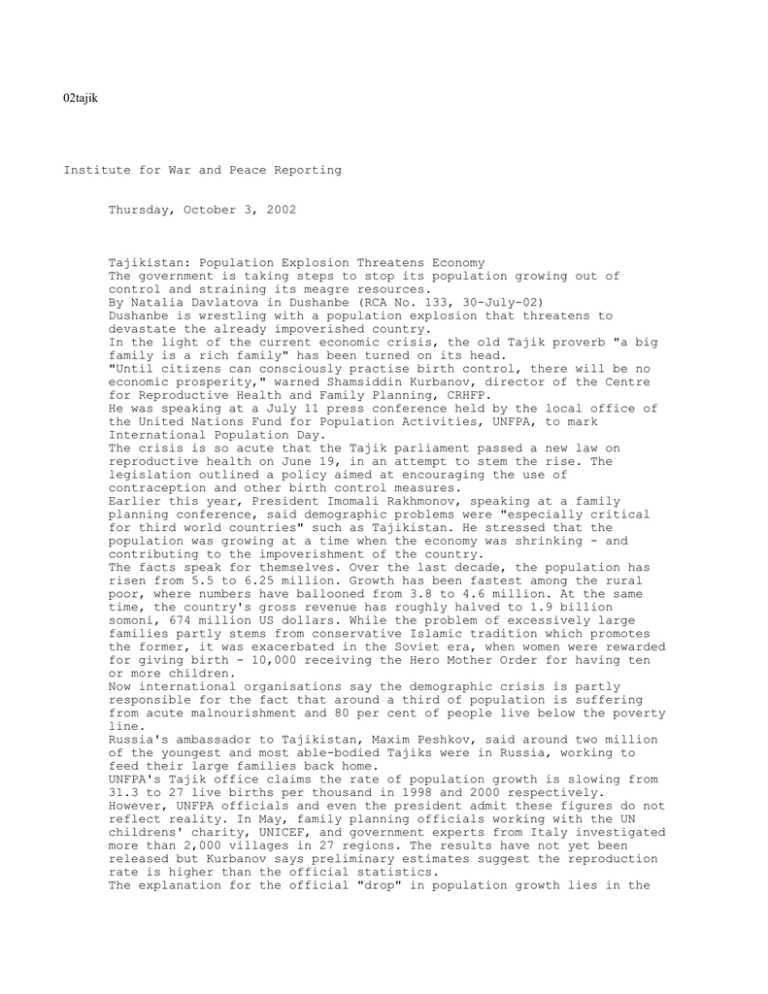
02tajik
Institute for War and Peace Reporting
Thursday, October 3, 2002
Tajikistan: Population Explosion Threatens Economy
The government is taking steps to stop its population growing out of
control and straining its meagre resources.
By Natalia Davlatova in Dushanbe (RCA No. 133, 30-July-02)
Dushanbe is wrestling with a population explosion that threatens to
devastate the already impoverished country.
In the light of the current economic crisis, the old Tajik proverb "a big
family is a rich family" has been turned on its head.
"Until citizens can consciously practise birth control, there will be no
economic prosperity," warned Shamsiddin Kurbanov, director of the Centre
for Reproductive Health and Family Planning, CRHFP.
He was speaking at a July 11 press conference held by the local office of
the United Nations Fund for Population Activities, UNFPA, to mark
International Population Day.
The crisis is so acute that the Tajik parliament passed a new law on
reproductive health on June 19, in an attempt to stem the rise. The
legislation outlined a policy aimed at encouraging the use of
contraception and other birth control measures.
Earlier this year, President Imomali Rakhmonov, speaking at a family
planning conference, said demographic problems were "especially critical
for third world countries" such as Tajikistan. He stressed that the
population was growing at a time when the economy was shrinking - and
contributing to the impoverishment of the country.
The facts speak for themselves. Over the last decade, the population has
risen from 5.5 to 6.25 million. Growth has been fastest among the rural
poor, where numbers have ballooned from 3.8 to 4.6 million. At the same
time, the country's gross revenue has roughly halved to 1.9 billion
somoni, 674 million US dollars. While the problem of excessively large
families partly stems from conservative Islamic tradition which promotes
the former, it was exacerbated in the Soviet era, when women were rewarded
for giving birth - 10,000 receiving the Hero Mother Order for having ten
or more children.
Now international organisations say the demographic crisis is partly
responsible for the fact that around a third of population is suffering
from acute malnourishment and 80 per cent of people live below the poverty
line.
Russia's ambassador to Tajikistan, Maxim Peshkov, said around two million
of the youngest and most able-bodied Tajiks were in Russia, working to
feed their large families back home.
UNFPA's Tajik office claims the rate of population growth is slowing from
31.3 to 27 live births per thousand in 1998 and 2000 respectively.
However, UNFPA officials and even the president admit these figures do not
reflect reality. In May, family planning officials working with the UN
childrens' charity, UNICEF, and government experts from Italy investigated
more than 2,000 villages in 27 regions. The results have not yet been
released but Kurbanov says preliminary estimates suggest the reproduction
rate is higher than the official statistics.
The explanation for the official "drop" in population growth lies in the
fact that children are only given birth certificates on enrolling in
school. Many parents in rural areas cannot afford to educate their
families, so their kids go unrecorded.
The rural areas - where around three-quarters of the population resides face the biggest economic danger faces. A low level of economic growth
means the majority have to live off what they grow.
President Rakhmonov says the population may reach eight million by 2010,
which means today's average of 0.1 hectare of irrigated land per
inhabitant will fall to 0.08, which is inadequate for even subsistence
faming. Because of the country's mountainous geographical location, an
increase in the total area under agricultural cultivation is not feasible.
The situation has deteriorated in the five months. In the south of the
country, torrential rains, hail and floods this spring washed away much of
the fertile topsoil on the best-irrigated land. To make matters worse,
this was followed by an unprecedented plague of locusts.
Tajikistan, now the poorest country in the CIS, cannot feed its people and
the only solution is the continued migration of working-age males to
Russia, Kazakstan and Kyrgyzstan.
However, this generates other problems. According to Kurbanov, the general
health of the population is declining partly as a result of sexually
transmitted diseases brought home by Tajiks who have been working
elsewhere. CRHFP says 34 per cent of women of childbearing age in the
southern Khatlon Oblast are suffering from venereal disease.
Around four to five per cent of children in this area are born with
congenital syphilis. As the men do not protect themselves from sexually
transmitted diseases, many children are born with defects, damaging the
gene pool as a whole.
CRHFP specialists are trying to educate the population about birth
control, and special attention is given to villagers who not only cannot
afford contraception but do not even know what it is. Even among the urban
population, the main method used is abortion.
Natalia Davlatova is a journalist with Telecom Technology in Dushanbe
Send this article to a friend
Recent IWPR Stories of Related Interest:
Tajikistan: Downpours Bring More Misery
By Ilkhom Narziev in Dushanbe (RCA No 123, 07-June-02)
Tajiks Nervous About Chinese Ties
By Vladimir Davlatov in Dushanbe (RCA No. 122, 31-May-02)
IWPR thanks the following for their generous support:
© Institute for War & Peace Reporting
Lancaster House, 33 Islington High Street, London N1 9LH, UK
Tel: +44 (0)20 7713 7130
Fax: +44 (0)20 7713 7140
The opinions expressed in IWPR Online are those of the authors and do not
necessarily represent those of the Institute for War and Peace Reporting.
Registered as a charity in the United Kingdom (charity reg. no: 1027201, company
reg. no: 2744185)
Economist.com
2
Tajikistan
Wars and shadows of wars
Jul 25th 2002 | DUSHANBE
From The Economist print edition
Tajiks need peace in Afghanistan
WHEN the Taliban regime in Afghanistan was overthrown by the anti-terror
coalition last December, the leadership in neighbouring Tajikistan was
thoroughly delighted. It seemed to offer hope to a poverty-stricken country
still struggling to recover from its own civil war that ended five years ago and
cost an estimated 60,000 lives.
The Taliban had been a continuous threat to the stability of Tajikistan, the
only country in Central Asia that has allowed Islamists to become part of its
government, under the terms of the peace agreement signed in June 1997. The
president, Imomali Rakhmonov, strongly opposed the Taliban and supported the
Northern Alliance long before the rest of the world began to take much notice of
Afghanistan. Most of the world seemed to be waiting only for the Taliban to
conquer the whole of the country before, with a show of reluctance, granting
them diplomatic recognition. Luckily for Mr Rakhmonov, September 11th has
changed the equation, boosting the Tajik government in a number of ways.
First, it enabled Mr Rakhmonov to carry out some long-overdue housekeeping. For
example, around 15% of the commanders in the powerful border-control forces were
recently sacked. “This could not have been done in 1999 or 2000, or even before
9/11,” says an observer. The role of law-enforcement organisations, the militia
and judges are all now under review, reflecting Mr Rakhmonov's new feeling of
security.
Peace in Afghanistan, if it lasts, should in principle also offer Tajikistan new
possibilities for economic development and trade. Held back by its civil war and
subsequent instability, Tajikistan has been slower at implementing economic
reforms to make the transition from a command to a free-market economy than the
other former Soviet republics. Being landlocked, Tajikistan, potentially an
exporter of gold and other precious metals, is dependent on long transport
routes and consequently on good relations with its neighbours.
For the present, Tajikistan's economy is still in dire straits. The United
Nations reckons that about eight out of ten Tajiks live in poverty. Unemployment
is so high that up to 1m souls out of a population of more than 6m migrate to
Russia for work every year. Since those lucky enough to find work in Tajikistan
can expect an average monthly salary of just $10, it is no surprise that
Russia-bound flights are packed. Getting a train ticket can take weeks.
The departure of such a large portion of the male population causes extra social
problems at home. Wives are left behind to fend for themselves and to raise
their usually sizeable brood of children alone. Those women who are unable to
find husbands settle for becoming second or third wives in the hope of finding
financial protection and respectability, even though neither they nor their
children have any legal rights in case of abandonment.
Reducing poverty and solving such problems are primary goals for Mr Rakhmonov's
government. One country the Tajiks would like to see become more involved is
Russia, still Tajikistan's principal strategic partner despite America's
increased presence in Central Asia. But although Russia continues to keep its
201st motor rifle division in the capital, Dushanbe, and has agreed to set up a
military base in the country, this is one former republic in which Russia seems
neither able nor willing to invest.
Relations with Uzbekistan, through which Tajikistan's railway runs before
reaching Kazakhstan and Russia, remain particularly difficult. In the past few
years, the Uzbeks have accused Tajikistan of endangering their security by
3
permitting drug trafficking from Afghanistan and failing to prevent Islamists
from attacking Uzbek territory. As a result of this, Uzbekistan decided to plant
mines along its border with Tajikistan, without informing the Tajikistan
authorities of their location. To date, they have killed at least 55 Tajik
civilians and injured over 200.
Tajikistan remains an edgy place in a dodgy neighbourhood. Most Tajiks, though
weary of conflict and instability, are well aware that no disarmament followed
the end of the civil war. The weapons were simply stashed away, and are ready to
be pulled out at any moment.
Copyright © 2002 The Economist Newspaper and The Economist Group. All
rights reserved.
Bove, Roger E.
From: Majordomo@guardian.co.uk
Sent: Wednesday, August 28, 2002 8:02 PM
To:
rbove@wcupa.edu
Subject:
Majordomo file: list 'guardian-weekly' file 'gwinternational/2002.9.1/200208293301'
-Washington Post / Tajiks upbeat about 'most backward' republic / Robert G. Kaiser in
Dushanbe
Tajiks upbeat about 'most backward' republic
Economic woes and drugs trade cloud the future
Robert G. Kaiser in Dushanbe
The news from Tajikistan is mostly bad. At least 80 percent of the population of 7
million lives in poverty, and a third of the children are malnourished. A million
Tajik men have fled to Russia to look for work, stranding their families here. Most
of the heroin used in Europe passes through Tajik territory, leaving a rising number
of local addicts in its wake.
Rampant corruption discourages potential investors in the struggling economy.
Tajikistan has modest natural endowments, and no oil or gas. An impoverished
government has a total budget for 2002 of barely $175 million.
And yet, the mood in this tree-lined capital nestled beneath the snow-capped Hissar
mountains is decidedly upbeat. Citizens and officials speak enthusiastically about an
improving economy, stable national politics and an easier atmosphere in the country.
Tajikistan today is full of reminders that "compared to what?" can be one of life's
most revealing questions.
Here the comparisons are to the first years of independence after the Soviet Union
crumbled in 1991. Starting out as "the most backward of all the former Soviet
republics by any measurement," in the words of President Imamali Rakhmonov,
Tajikistan quickly stumbled into a civil war.
The war, a struggle for power among competing clans, killed between 65,000 and
150,000, created more than a million refugees and stymied the country's development
for five years. People were gunned down on the streets of Dushanbe. Residents of the
capital can all tell tales of survival from a time when some never left home for
4
months on end. Only in 1997 did the warring factions make peace, after Russian troops
helped the government put down rebels led by the Islamic Renaissance Party. Only last
year did the threat from Tajikistan's next-door neighbor subside.
That threatening neighbor was Afghanistan, which shares a mountainous, 800-mile
border with Tajikistan. For years Tajikistan warned the world that the Taliban who
ruled Afghanistan were fundamentalist fanatics who posed a real danger to
international peace. In 1998 Rakhmonov suggested, in a speech to the United Nations,
that the international community surround Afghanistan with a "security zone" to
protect its neighbors.
"To our great disappointment, the world only turned to this problem after the tragic
events in the U.S." of September 11, Rakhmonov said in an interview here.
But the news from Tajikistan remains mostly bad. Like all the new nations of former
Soviet Central Asia, this republic was ill-equipped for independence and is still
struggling to find its way.
The government "is desperate" to revive the economy, according to a Western diplomat
here, but doesn't know what to do. It hopes for money from abroad, and has received
quite a lot, but donations have rarely created meaningful economic activity.
Corruption, over-regulation, senseless tax policies and inertia have frustrated the
development of a private sector beyond retail trade and simple
services, according to business people, bankers and diplomats here.
The economic situation "is very critical, very bad," said Sulton Kuvatov, a former
officer in the Internal Affairs Ministry who is trying, unsuccessfully, to register
an opposition political party. "I don't see a future" for the Tajik economy, he
added, predicting that poverty could persist for a generation.
Afghanistan still casts a dark shadow across Tajikistan. It does so with poppies and
the opiates made from them, especially opium and heroin. Afghanistan is now the
source of 90 percent of the heroin consumed in Europe, according to the U.N. drug
control office, and most of Afghan
istan's production passes through Tajikistan on its way to market.
This trade has had devastating consequences in Tajikistan. Tajiks' share of the drug
business may total $200 million a year, according to a senior U.S. official here,
though this can only be a guess. Another Western diplomat estimated that drug money
constitutes about a third of the gross domestic product of the country.
A good portion of this money probably ends up in the pockets of government officials.
The fruits of the drug trade are visible on Dushanbe's boulevards, where a Jaguar or
Mercedes convertible may appear, and in the upscale neighborhoods of this city.
The drug trade has also created local users, some of them drug couriers who are paid
in cheap, impure heroin.
The ugliness of the drug trade contrasts with the satisfaction evident throughout
Tajik society over the resolution of the civil war. In June the country formally
celebrated the fifth anniversary of the peace accord, which led to a formal powersharing arrangement. Rakhmonov invited representatives of the Islamic opposition into
his government, where they still sit - the only officially recognized Islamic
opposition in Central Asia.
But it is easy to find politicians, journalists and intellectuals in Tajikistan who
say the opposition was bought
off with jobs and that no real sharing of power has occurred. The news media are
also intimidated, according to editors and foreigners who work with local news
organizations.
One of the saddest spots in Dushanbe is the leafy square in front of the train
station, where single men congregate at all hours, hoping to buy tickets to Russia.
Survey research done for the United Nations suggests at least a million men have gone
to Russia for work, according to pollster Muzaffar Olimov.
"It will be very hard to make this anything more than a well-managed poor country,"
said a sympathetic American official here.
The Guardian Weekly 29-8-2002, page 33
5
posted on TOL Wire on 26 November 2002
Tajikistan Has the Least Developed Economy in the CIS
from TCA
DUSHANBE, 26 November (TCA)--Tajikistan's economy has a pronounced economic focus on
raw material and natural resources. The Tajik Aluminum Plant forms the core of the
industrial output. The plant has developed successfully in part because of the cheap
electricity supplied by local hydroelectric plants. Tajikistan has the largest
hydroelectric resources in the former Soviet Union. Light industry is currently on
the decline in the country.
Tajikistan this year, as in 2001, reported economic growth. GDP in the first nine
months of the year expanded by a rate of 8.9% from the same period last year to 2.173
billion somoni in current prices. Industrial output was up 6.7% to 1.696 billion
somoni.
Since Tajikistan declared independence in September 1991,
seen in the Tajik economy. Industrial output and GDP have
civil war in Tajikistan further hurt the economy, setting
decades economically and complicating the transition to a
negative changes have been
dropped considerably. The
the country back several
market economy.
By the middle of the 1990s a unique sort of situation had developed in Tajikistan
where the currency of another country, Russia, circulated as cash and old Soviet
rubles were used in non-cash payments. The catastrophic difference in these
currencies proved devastating to the financial system. Because the cash in
circulation had been borrowed from Russia Tajikistan's debt to Russia increased
sharply. The systematic non-payment of wages, pensions, and compensation,
interruptions in the functioning of the payment system, and an increase in domestic
and foreign debt became the main economic problems for Tajikistan.
The government decided to introduce a national currency, the Tajik ruble, in an
effort to remedy the situation. The government in an effort to eliminate the
difference in non-cash and cash circulation, and to reduce the amount of money in
circulation, converted assets at 100:1 for cash assets and 1200:1 for non-cash
assets. The Tajik Interbank Currency Exchange was founded in April 1995. Tajikistan
made considerable progress in liberalizing prices, including prices for bread and
flour, that were previously subsidized and liberalized currency operations and
foreign trade. All export duties were eliminated in March 1996, as were import duties
for petroleum products and aluminum.
The measures taken to stabilize the economy brought positive results in 1996.
Inflation fell from 2100% in 1995 to 40% in 1996 and the nominal exchange rate was
fairly stable at 300 Tajik rubles to the U.S. dollar. But a new wave of instability
in the first half of 1997 interrupted efforts to stabilize and reform the financial
sector. Due to the unforeseen pressure on the financial system the budget deficit
increased substantially, accompanied by an increase in the money supply and loans.
The Tajik president on 16 July 1997 signed a decree on measures destined to stabilize
the economy and improve the functioning of the currency market that banned the issue
of new foreign currency loans and took measures to repay those already made. Limits
on bank lending were strictly regulated. Monetary reforms continued with the
introduction in 2000 of a new national currency, the somoni, a decision that was
supported by the International Monetary Fund (IMF) and World Bank. The initial
exchange rate for the new currency was set at 2.2 somoni per $1. By the end of
October 2002 the official exchange rate was 2.9527 somoni per $1. Since its
introduction the somoni had devalued at a rapid pace of more than 34%.
6
The economic situation makes Tajikistan eligible for aid and low interest loans from
the world community. The main donors have been the World Bank and IMF, which since
1997 has provided $140 million. The IMF programs in Tajikistan are aimed at lowering
inflation, increasing reserves of convertible currency, strengthening the national
currency, and slowing the drop in production.
An IMF mission visits Tajikistan regularly to evaluate economic reforms. During the
most recent mission in October, Robert Christensen, head of the mission, met with
Tajik President Emomali Rakhmonov and noted that the economy was growing. He noted an
increase in agricultural production particularly the high yielding wheat and cotton
harvest this year. However, the IMF is concerned by inflation in Tajikistan and
recommended a tighter monetary policy.
Tajikistan also receives aid from other governments and some international
humanitarian organizations. The most active have been the governments of Japan, the
United States, China, the European Union, the International Red Cross, and others.
They have provided mainly medicine, food, and medical equipment.
Hydroelectric plants are the strongholds of the power industry in Tajikistan it
produces just 50% of the energy it consumes. Many villages still have no electricity.
Fuel deliveries from Uzbekistan, imported largely by power plants, have been
interrupted several times in recent years due to Tajikistan's debt. During the civil
war in the 1990s many power plants were damaged, which resulted in a drop in
electricity production.
Electricity production in 2001 increased from 2000 by just 0.7%, which was down 20%
from 1991.
If Tajikistan fully utilized its hydroelectric resources Tajikistan could become the
biggest electricity exporter in the region. However, the natural wealth is used
inefficiently, so Tajikistan doesn't have enough electricity and must import from
neighboring countries. Tajikistan lacks the investment resources to build new
hydroelectric plants or reconstruct those destroyed in the war. It needs large
foreign investment that the country is not receiving due to political instability and
tension, although the country's investment laws provide significant perks for foreign
investors.
Copyright © 2002 Transitions Online. All rights reserved.
Country Guide / The Times of Central AsiaDaily news from
Central Asia!
Wednesday, Nov 27, 2002
Country Guide:
Afghanistan
Tajikistan
7
Economic
GDP nominal: $955 million
GDP per capita (2000): $154/per capita
Inflation rate: 33%
Natural resources: Hydropower, some petroleum,
uranium, gold, mercury, brown coal, lead, zinc,
antimony, Tungsten
Unemployment rate: 54.1% (1998), under-employment
also is high; 80% live under the poverty line
(2001)
Agriculture: Products--cotton, grain, fruits,
grapes, vegetables, cattle, sheep, goats
Industry: Types--aluminum, zinc, lead, chemicals
and fertilizers, cement, vegetable oil, textiles,
Metal-cutting machine tools, refrigerators, and
freezers
Trade: Exports--$792 million (2000): aluminum (49%),
electricity (23%), cotton (12%), gold, fruits, vegetable
oil, and textiles. Partners--Europe 43%, Russia 30%,
Uzbekistan 13%, Asia 12%, other CIS 2% (1997).
Imports--$839 million (2000.): electricity, petroleum
products, aluminum oxide, machinery and equipment,
foodstuffs. Partners--Other CIS 41%, Uzbekistan 27%,
Russia 16%, Europe 12%, Asia 4% (2000).
External debt total (2000): $1.2 billion. Bilateral
external debt: total --$509 million: Uzbekistan $130
million, Russia $288 million, U.S. $22 million, Turkey
$26 million, Kazakhstan $19 million, Pakistan $16
million; multilateral debt: total--$365 million: World
Bank $153 million, IMF $113 million, ADB $19 million
(2000). Debt/GDP ratio (2000): 129.
Economic Overview
The collapse of the trade and payment system, the
deterioration of the terms of trade, and the absence of
union transfers from Moscow, which had been the main
method of funding Soviet Republics during the Soviet
period, have inflicted significant damage to
Tajikistan's economy. The move from a command economy
under the Soviet system to a more open and
market-oriented economy has been an onerous task,
replete with legislative, institutional, and cultural
obstacles. These obstacles have been compounded by civil
war and natural disasters. As a result of political
instability, Tajikistan has been late in receiving the
international monetary assistance and foreign investment
that other former Soviet Republics have already
received. On the economic front, the government of
Tajikistan now appears to be ready to do the work
necessary to receive international donor support and to
return Tajikistan to the standard of living experienced
prior to the outbreak of the civil war.
While Tajikistan has had problems with economic reform,
it has shown recent signs of improvement. From
January-April of 2001 Tajikistan had the highest
industrial output growth among Central Asia and Caucasus
States. In the four months of 2001 the CIS
8
intergovernmental Statistical Committee reported
Tajikistan's industrial output growth at 14 percent, 3
to 9 percent higher than its Central Asian and Caucasus
counterparts. GDP grew by an estimated 8.3 percent in
2000.
Tajikistan has also shown positive indicators of
macroeconomic growth in the beginning months of 2001.
From the months of January-May 2001, Tajikistan's GDP
grew 7.9 percent and measured 682.7 million Somoni in
current prices. The almost 14 percent industrial growth
rate totaled 777.670 million Somoni. Consumer goods
output was up 43.5 percent to 202.205 million Somoni,
and the average unemployment rate fell to 14.9 percent.
With the assistance of the IMF, Tajikistan has
established a three-stage economic reform process
designed to carry the country into the next century. The
first stage (mid-1995/1997) focused on improvement in
the legal infrastructure, reforms in the agricultural
sector, privatization of small-scale enterprises, and
creation of favorable conditions to attract foreign
investors. The second stage (1998- 2000) focused on the
privatizing of large-scale enterprises, and establishing
efficiently- functioning banking, credit and taxation
systems. The third stage (2001+) focuses on the further
modernization of the economy, the formation of an
efficient infrastructure and the implementation of
large-scale socio-economic programs.
There appears to be a good degree of political will
behind the reforms and their implementation. Progress
has been slow, but steady. Partially to reward the
government's implementation of some economic reforms and
to encourage more, international financial organizations
such as the IMF and the World Bank have begun an
infusion of credit to Tajikistan which should straighten
the path of economic reform. On June 15, 1999, the World
Bank approved three credits worth a total of $31.7
million with $20 million being used to support the
privatization of farms. In addition, the World Bank and
the Asian Development Bank (ADB) plan to provide $25
million to Tajikistan to help support the country's
budget. The IMF is providing a credit of $18 million to
support the exchange rate of the national currency of
Tajikistan.
Structural reforms have accelerated, particularly in the
field of trade and foreign exchange liberalization. In
October 2000 Tajikistan adopted a new currency, the
Somoni, a move supported by international financial
institutions. Currency conversion was completed in April
of 2001. The IMF approved a new Poverty Reduction and
Growth Facility (PRGF) in October worth US$ 51 million
to support the new currency and wider economic reforms.
Agriculture
The agricultural sector is the major employer (64.8% of
the work force) and the most important economic activity
in Tajikistan. Farming accounts for about 17 percent of
GDP. Besides cotton and grains Tajikistan also produces
fruits and vegetables and is involved in horticulture.
Apricots, pears, apples, plums, quinces, cherries,
pomegranates, figs, and nuts are produced. Agricultural
9
production makes a significant contribution to the
balance of payments. Agriculture and agribusiness have
helped lead the way towards economic recovery for the
country since independence. Agriculture is more
mechanized in Tajikistan than in neighboring countries
although the country now faces shortages of spare parts
and adequate maintenance.
Although the agricultural sector is one of the most
modernized in the NIS, total output has been declining
sharply during the last five years. Cotton yields, for
example, are suffering from a lack of fertilizers,
pesticides and herbicides.
The main crop production areas lie in the irrigated
valleys of the tributaries of the Amu and Syr Darya
rivers. About 8,000,000 hectares of land are under
cultivation, mainly in the hands of state and collective
farms. Cotton, which is the major cash crop accounting
for about two thirds of the gross production value of
the agriculture sector, takes up 35 percent of the
cultivated area.
Agriculture in Tajikistan offers virtually unlimited
opportunities for investment in terms of capital, joint
ventures and the transfer of know-how. This includes
improved management techniques, better irrigation
practices, the use of basic agricultural chemicals, and
more efficient harvesting and distribution. In addition,
there are many opportunities to increase the added value
of products through more quality control, processing,
packaging and sales and distribution, which are still
undeveloped. Currently, 40 to 50 percent of fruits and
vegetables harvested are wasted because of the lack of
preservatives and of technology for producing smaller
packaging. The first loan signed by the Dushanbe office
of the Central Asian-American Enterprise Fund was for a
cannery on the outskirts of Dushanbe. A visit by BISNIS
in May 1996 revealed an intense interest in both
northern and southern Tajikistan for food processing
ventures and food packaging ventures to take advantage
of the country's rich agricultural output and export the
products to Russia, the NIS, and surrounding countries.
The cotton and grain production was hit hard by the
drought in the summer of 2000 that went throughout
central Europe. International aid was given to
Tajikistan to help feed the population and imports of
grain and wheat increased by 20 percent.
Various international programs are under way to develop
the agriculture sector in Tajikistan, Including a World
Bank project designed to help farmers designed to help
farmers respond to market demands and grow products
accordingly. The Asian Development Bank (ADB) has
technical aid and programs totaling US$ 150 million to
rehabilitate the agricultural sector over the next three
years by developing agricultural trade and investment in
rural areas, training experts, and providing technical
support.
GENERAL INFORMATION:
Facts at a Glance, Flag Description, State Symbol,
National Anthem, Constitution, Country Map, Survival
Info, Embassies, Visa Application Procedure, Money and
10
Costs, Holidays, Useful links
COUNTRY PROFILE:
Geography, Main Cities, Climate, Forest resources, Water
resources, History, State Structure, Imomali Rakhmonov,
Parliament, The Council of Ministers, Cabinet Members,
Economic Overview
TO AND IN:
Culture & Arts, Tajik Cuisine, What to see, ABC, The
Languages of Tajikistan
Contacts
Advertise
Copyright © 1999-2002
Banners
About TCA
The Times of Central Asia
11

